Spinach: What Can Go Wrong
Is spinach on your list of crops you want to grow in your garden? If so, you may wonder how difficult it is to grow. Is it as easy as other greens?
According to Cornell University, Spinach is classified as a “moderately difficult” plant to grow. And while this may be true, I’ve found that spinach is an excellent crop to grow as long as you follow some basic spinach rules. If you are new to gardening, you might not know that spinach is a delicious crop that grows best in the cold. If you grow it in the cool season, and you avoid some of these common pitfalls that I’ll share with you, you could be well on your way to eating your own homegrown spinach.
Fresh spinach right from the garden is delicious! It’s also an excellent source of necessary vitamins and that alone is a great reason to consider planting spinach in your garden.
Did you know that just one cup of spinach provides 56% RDA Vitamin A and 14% Vitamin C? Also, it has calcium, iron, fiber, Vitamin K, folate, magnesium, Vitamin B6, potassium, riboflavin, and even 1g of protein.
Let’s go over some of the common mishaps associated with this cold-loving crop.
How Spinach Likes to Grow
Before you plant, understand that the timing of your planting makes all the difference. Spinach loves cool to cold weather. In fact, spinach seeds germinate best in 40F-70F and their ideal temperature for growing abundantly is 50-60F. If you try to plant seeds when the soil is still too warm, your seeds won’t germinate at all.
This makes spinach a great addition to your garden when the weather is cooler outside and a lot of other crops won’t grow.
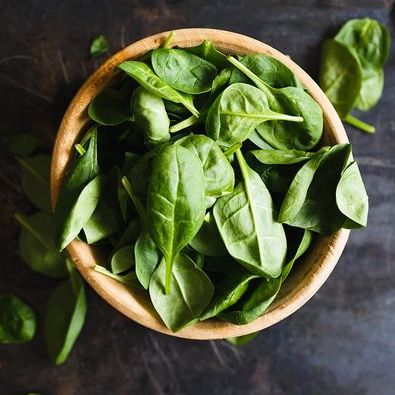
What Can Go Wrong During Spring Planting
If you are going to plant spinach in the spring, make sure you don’t make the same mistake that a lot of new gardeners make: don’t sow your seeds too late because the plant will likely bolt. You’ll know when spinach bolts because it starts developing a central stem in the middle that eventually develops into a flower. While spinach doesn’t turn bitter as fast as lettuce does, when you notice spinach bolting, it’s time to harvest as many leaves as you can and then pull the plant to make room for warm season crops.
Spinach seeds perform best when directly sown into the ground, but if the temperature of your soil is 50 degrees or below, your seeds might take up to 3 weeks to germinate. For plant timing, spinach is usually between 4-8 weeks before your average last frost date. Of course, this time may vary depending on where you live. If you are still under heavy snow cover during that time period, you may have to wait until the snow is gone or the ground is thawed to get the seeds in the ground.
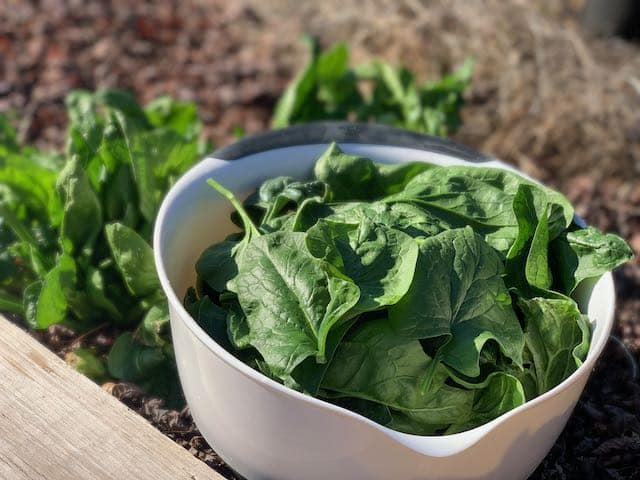
What Can Go Wrong During Fall Planting
In the fall, most gardeners plant too early and their seeds don’t germinate at all in hot soil. Sometimes the young plants bolt right away because the soil is still too warm for proper growth. Remember, spinach loves the cold — not the heat.
According to Cornell University, spinach seeds only take 5 days to germinate when the soil temperature is 77, but the germination rate drops to 30%. When I’m planting spinach in the fall, I like to sow extra seeds to account for the lower germination rate.
Usually the best rule of thumb for planting spinach in the fall is to plant around 4-6 weeks before the average first frost and up to 8 weeks in less hot areas. Since I live in a mild climate (zone 7b), I like to plant my seeds in late September for a mid February harvest. Harvest time varies depending on your climate as well. You may have to try several times to find what works best for your location.
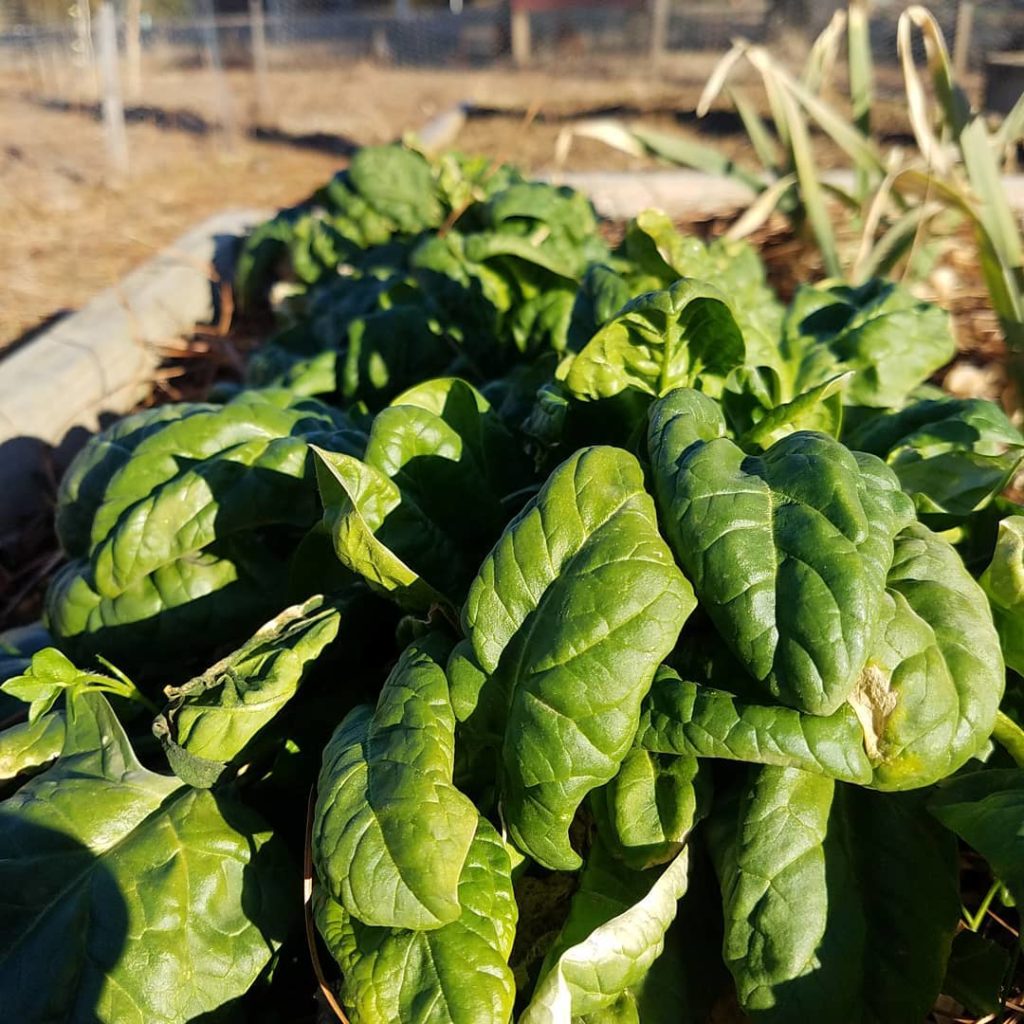
Bolting – Why Does it Happen?
Another common problem with spinach is bolting. Bolting is when a plant starts to set seed too early due to stress or weather (or both). This can alter the flavor of the crop and potentially even make it bitter. Although spinach plants have a taproot, they are generally shallow-rooted, causing them to be more prone to water stress. When a spinach plant is under stress, has dry soil, and is growing under elevated daytime temperatures it may bolt. One thing you can try to avoid bolting is make sure your growing area is well-mulched.
Another reason your spinach may bolt — particularly in the spring and summer — is because the daylight is longer. While most plants need a certain amount of light to grow, they also need a certain number of hours of darkness to thrive as well. While you can’t do much about this, shade cloth can help extend the season especially if your temps don’t get hot in the summer very fast.
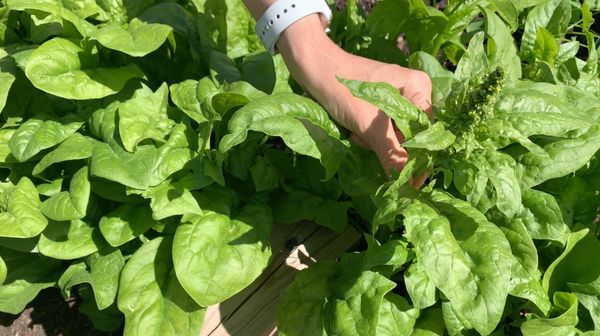
Bolting – How to Avoid It
Most of the time, bolting can be avoided by simply planting when the soil is cool. Heat is usually a big culprit when your spinach bolts, but it can also bolt because the soil is dry or the days begin to lengthen. I will usually see bolting in my garden when daytime temps reach 75 degrees. This is why Penn State Extension actually recommends a shade cloth when temps get to 70F.
You can also choose some bolt resistant varieties of spinach, like Lizard, Seaside, Indian Summer, and Olympia. Test different varieties in your garden.
Soil Conditions for Healthy Spinach
Your soil is a big part of why your spinach harvest will be abundant. The best type of soil for spinach is well-drained, rich in organic matter, and has consistent moisture. You’ll want to make sure you soil has a pH of at least 6.0-7.5. If you don’t know what the pH level of your soil is, your best bet is to get a soil test. My favorite way to test my soil is through SoilKit. You can do that here (and use my affiliate code JILL5 to get $5 off one soil test).
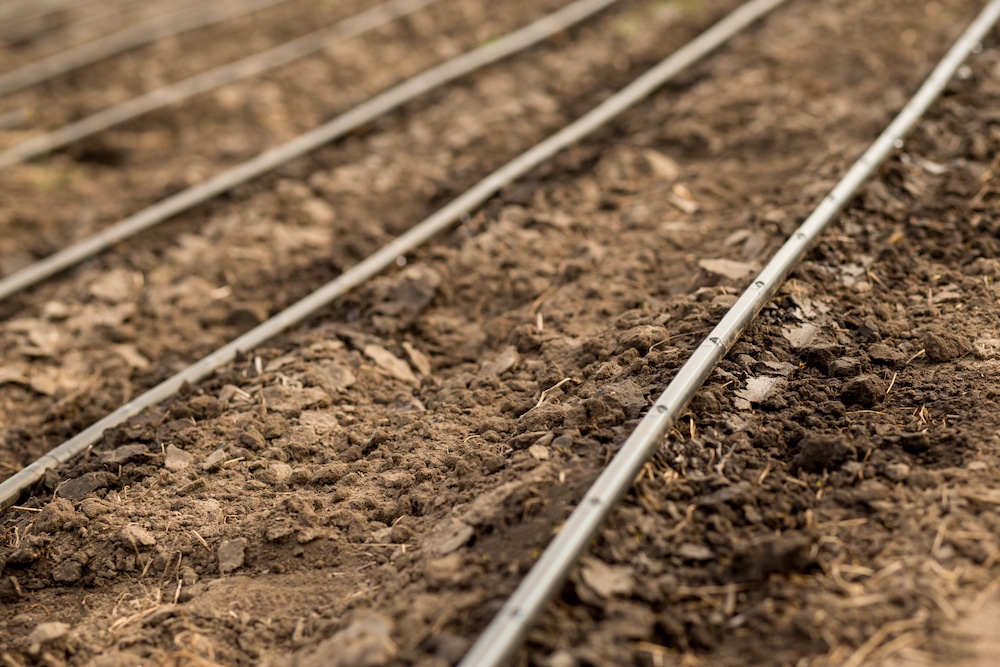
Without a soil test you might notice that your spinach leaf tips and margins are yellow or brown and that would indicate that your soil is too acidic. You might even notice poor germination. Doing a soil test can tell you what you need to do to properly prepare your soil to ensure maximum spinach harvest. If you do need to add lime to your soil, make sure to add it 3 months prior to planting for best results.
Growing Tips
Spinach Doesn’t Get Too Hungry
Spinach is not a particularly hungry plant, so you won’t need to fertilize too often and make sure you don’t over-fertilize with nitrogen. The only time you would fertilize with nitrogen is if your leaves are pale green.
Use Correct Spacing for Your Needs
The plant spacing for spinach really depends on what you are wanting out of the crop. Baby spinach can be planted closer together but larger leaves should be spread out farther. Spinach is the perfect crop to scatter by hand over a large area by using the broadcast sowing method. Then, harvest baby spinach, leaving some plants in the garden in order to achieve the ideal minimum of 2-6 inches between each spinach plant. Let those grow into mature spinach leaves.
Sunlight Requirements
Spinach likes full sun in the cold weather (with shorter days). As the day length increases and temperatures warm up, they prefer part-shade. You’ll want to shade your spinach in the early spring and summer so they will last longer before they begin to bolt.
Disease Issues
The main disease that can affect the growth of your crop is Downy Mildew. This fungal disease is a type of water mold that causes yellowish spots on your spinach leaves. Thankfully, I’ve never experienced Downy Mildew on my spinach, but it is common. You can avoid it by making sure you properly space your spinach plants to increase the airflow between plants. Also, make sure you only water the soil, not the leaves.
Spinach is a great crop for small locations as well. It can fit into containers well, especially the Greenstalk Vertical Planter, (use my code JILL10 for $10 off your order of $75 or more). It is a great addition in your garden when the weather is too cool for most other crops to grow.
If you’ve grown spinach before with limited success, keep trying! Keep in mind how it grows best and don’t give up. Spinach is a nutritious, rewarding crop that you can enjoy in your garden throughout the cool months.
Do you get overwhelmed with garden planning?

Subscribe here for my best tips to plan your garden in just 7 days -- all for FREE.
Plus, I'll send you my "In the Garden E-mail" on Fridays, periodic updates on garden resources relevant to you, and you'll receive access to my entire bank of free garden downloads!
You are also agreeing to our privacy policy.


Thanks for the info on spinach. I am growing it in my garden for the first time this fall. Z8 Alabama.
Love your articles!
Your first pic in this article shows a slug/snail on a leaf yet you never address pest. This last winter in central Virginia had few if any freezing days. Thus, the snail population is very bad this year. I grow in raised planter boxes with organic soil and organic treatments.
How do we combat the slugs, organically?
Thx,
R
I don’t personally treat for slugs. I find them to be manageable until our weather dries out, but I know other areas battle them more than I do. I’ve heard of others using diatomaceous earth or beer traps. Eggshells do not work, from the studies I’ve seen. Using a copper wire barrier is also common, though I’m not sure how effective that is.
Jill,
My sincere thanks.
R